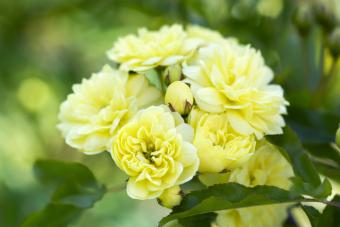
For how beautiful roses are, they pack a powerful bite. You seldom come away from pruning those colorful blooms unscathed; it doesn't matter if you've got gloves on your hands and sleeves to the wrist. That's where thornless rose bushes come to the rescue. A delightfully non-prickly category of rose bushes, thornless roses are a must-have if you don't want to treat your gardening war wounds anymore.
Are Thornless Roses Truly Thornless?

Roses and thorns go together like peanut butter and jelly, so it can seem unnatural for a rose to grow without thorns. However, there are many rose varieties that are marketed as 'nearly thornless.' There's a lot of debate over whether there are any truly thornless roses, as many of the "thornless" varieties actually grow a few sparsely spaced thorns on the stems, and others have thorns that aren't nearly as prickly as their full-thorn counterparts.
It's something to keep in mind when you're caring for your thornless roses. If you happen to come across a few small thorns, don't uproot your plant in the name of false advertising.
Zephirine Drouhin

Zephirine Drouhin is credited as the original thornless rose. It's a pink Bourbon rose bush that was bred in 1868 by the French breeder, Bizot. These heirloom roses are versatile, growing as a climbing bush or pruned down into a shrub. They perform best in zones 5-9 in full sunlight. Keep them well watered if you want to watch them grow bountiful blooms.
Thornless Beauty

Thornless Beauty roses aren't as popular today as they were in the 1930s when Nicholas Grillo bred them for the first time. They were so popular, in fact, that then First Lady Eleanor Roosevelt ordered them to be displayed in the White House. Considered the world's first thornless hybrid tea rose, these crimson petaled flowers are nearly impossible to come by today. Yet, they thrive the most in zones 6-9, and will stay in bloom all season long.
Lykkefund

Lykkefunds are an unusual type of rose bush and bear looser, less-full white petals with yellow centers. If you love a more densely packed look, this cluster forming rose bush is perfect for you. They're relatively hardy and can be planted in all kinds of soils. But, like many roses in this bunch, they prefer full sunlight. You'll get the best results with this thornless rose if you live in zones 5-8.
Lichfield Angel

Lichfield Angel roses look like they were made to be put into wedding centerpieces. A lovely apricot shade and bountifully petaled, these thornless roses grow to a moderate shrub size and produce a light musk. As with most of these roses, they prefer full sun and thrive the best in zones 5-8. And, they're rather young in terms of old garden roses, having been first bred in 2005.
Reine des Violettes

Another thornless hybrid rose to consider planting is the Reine des Violettes. These double rosettes pop up in a deep purple-pink shade less commonly associated with roses. Despite thriving in zones 5-9, you should be careful when planting these roses as they're more susceptible to disease than some varieties. But, so long as you're keeping them in full sun, slightly acidic soil and are checking over their leaves and stems for early warning signs, they should do well.
Lady Banks

Lady Banks climbing roses will bring some cheer to your outdoor landscape with their ruffled, yellow blooms. They can weather many climates, surviving throughout zones 6-11. Considering Lady Banks rose bushes can extend their vines up to 50' in length, you'll want to plant them alongside a trellis or other support system. Although they only bloom once a year, their bountiful plumage makes them a great choice if you're going for that cottagecore look.
Prairie Rose

Similar in color scheme to the lotus flower, prairie roses are a wild, thornless variety that's native to much of North America. If you're considering putting in a wildflower garden and just want to choose plants that are native to your area, then prairie roses are one of the best thornless options available. When untamed, these bushes can grow up to 12' tall and 10' wide, making them a dominating flower in your space. Grow these small-flowered bushes in full sun and well-drained soil, and they'll do most of the work for you. Also, since they're a wild species, they've got a better tolerance for bugs and disease.
Hippolyte

If you love big, dense blooms, Hippolyte roses are for you. An old-world rose bush that produces purple-red flowers, Hippolyte grows into a moderate sized bush. They thrive best in zones 4-8, and do need a little pruning to keep in show-stopping shape. These perennial roses need full sun, but you can plant them in multiple soil conditions.
Sign up for our newsletter featuring all the latest stories and products we love.
Chloris

An old-world rose with a quintessential pale pink color, Chloris is a standard thornless rose that evokes the romantic garden aesthetic. These perennials give off a wonderful fragrance and should be planted in zones 3-9. Since they can reach a full height of 7', consider keeping them cut back or use them as large border bushes. When planting Chloris roses, you can put them in just about any soil type so long as they get full sunlight from their spot.
Nevada

If you're looking for a rose that can handle some heat, look no further than the Nevada rose. A thornless rose bush that can get up to 7' tall, these shrub roses produce quaint little white flowers with yellow centers. Plant them in zones 4-9 in slightly acidic soil in full sun and keep them well watered. If you want a rose bush that doesn't quite strike someone immediately as being of the rose variety, this is a great choice for you.
The Best of Both Worlds

With thornless rose bushes, you get the best of both worlds. You can enjoy all kinds of different beautiful blooms that the rosa genus offers while keeping your hands well-protected. Whether you like large climbing roses, small hybrid teas, or want the wild look of a huge shrub, there's a thornless rose bush with your name on it.







